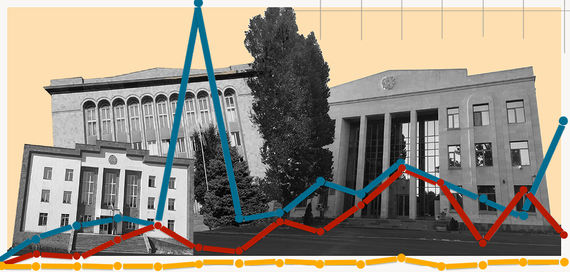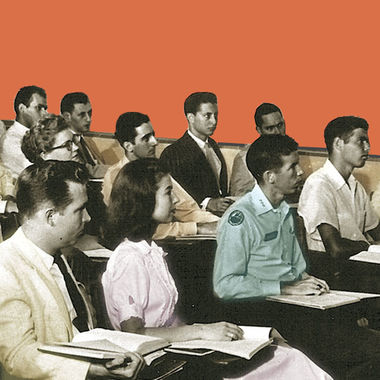Thu Sep 06 2018 · 9 min read
Araratian Baccalaureate: Transforming the Future or Creating Selective Education?

By Lusine Sargsyan

Almost immediately after his appointment as Minister of Education and Science, Arayik Harutyunyan made several controversial statements about the Araratian Baccalaureate (AB) program, a public-private partnership between the Armenian Government and Ayb Educational Foundation. Harutyunyan publicly questioned if the resources allocated to the program by the previous administration had been efficiently used and stressed that the Ministry, under his leadership, would stop financing “elite” schools moving forward. This led to heated discussions, especially on social media platforms. However, in an interesting turn of events, Minister Harutyunyan during a Facebook live on August 31 announced that it would indeed be beneficial if the AB system is introduced in all high schools countrywide.
Since its establishment in 2006, Ayb Educational Foundation has been an incubator for educational projects. In 2014, the Foundation, in collaboration with Cambridge Assessment International Education and Institute of Education at University College London, launched an extensive educational initiative, the National Program for Educational Excellence (NPEE). It was aimed at creating an internationally competitive alternative educational program for Armenian schools – the Araratian Baccalaureate and elevating the role of teachers in society. The program is co-financed by the Armenian government and Ayb Foundation. Discussions between the Foundation and the Government began in 2013, and by the last quarter of 2014, the implementation phase of the project kicked off. During the same year, the Government issued a decree stating that Ayb Educational Foundation would implement the AB program across Armenia.
AB is an internationally recognized Armenian-language educational program, similar to the International Baccalaureate (IB), that aims to transform every high school in Armenia ensuring compliance with internationally accepted standards. According to Narek Manukyan, Chief of Staff at NPEE: “The high school component of our educational system is not properly functioning because of multiple critical reasons, including the unclear purpose of high schools, the underdeveloped curriculum and examination systems.” Based on these factors, the Foundation identified a number of transformative components targeted to guarantee the successful implementation of the program.
1 - Introduce teaching transformation to allow local teachers become better professionals, who constantly study their classrooms and develop curriculum based on the unique needs of students. Manukyan stressed that to achieve the expected results, the Foundation offers a one-year long training program and does not intend to dismiss those teachers who do not match the required standards.
2 - Transform school leadership since research conducted by the Foundation revealed that most school leaders in Armenia are involved in the administrative side of governance. “If we want to have schools which provide competitive education, we also need to have teachers who understand teaching and motivate their students,” stressed Manukyan. “We need teachers who are not managers but rather leaders.” To reach this goal, one-year long school leadership training is offered to change the school administration’s mindset and introduce a novel approach to teaching.
3 - Transform the curriculum to equip teachers with the necessary tools to conduct their teaching effectively and efficiently. The curriculum aims to develop creative, reflective, and critical thinking skills, and is strongly interconnected with teaching transformation. “The school can have the most brilliant curriculum, but if we do not have the teachers who would be implementing that curriculum, it becomes absolutely useless,” explained Manukyan. He further emphasized that within the transformation, all the necessary resources will be provided to assure the successful operation of the curriculum.
4 - Substitute the existing examination system, which simply teaches students to memorize the material, with one that is flexible and elaborate enough to measure acquired skills. “The four components are interconnected and interdependent and with the smooth transition of the previous three, we will have exams that correspond to the new situation,” said Manukyan.
Since the start of the AB program, every year a contract was signed with the Ministry and an action plan, including financial and narrative reports were submitted to the Government. Manukyan said that the previous administration had been satisfied with the delivered results. So far, a teacher education plan has been finalized, tested, and provided to 100 teachers from the regions, AB exams have been piloted and an exam center established. Additionally, a school leadership program was developed, and the curriculum was constantly improved based on the experience of teachers. Today, 36 reputable universities from nine countries have added AB among the qualifications that are accepted for admission to an undergraduate program in those universities.
The basic philosophy of the AB program is to address Armenia’s unique needs: it can be quite challenging when a foreign education system is simply translated and implemented, Manukyan explained adding that each country has its own specific problems and strengths. He stressed the importance of a program geared specifically for the population serving local needs. “A program created locally gives a sense of ownership and the freedom to modify it when needed,” claimed Manukyan. “You own the capacity to always develop the program.” He noted that over the last 20 years, the Armenian Government has mostly borrowed policies from other countries, which severely hindered its ability to understand local problems, develop capacity, and strengthen the system.
Quality Education for All?
According to the initial plan, AB was going to be introduced in 14 schools in Yerevan, Artsakh and the regions. In 2015, however, following negotiations with the Government, the strategy was altered and it was agreed that AB will be introduced in all high schools as a fourth track along with the Arts and Humanities, Sciences, and General tracks to ensure that each student has the chance to be included in the program. This means that students would have the freedom to choose a track, and those wishing to be included in the AB program would be required to pass an additional placement test. “The purpose of the test is to identify how prepared a student is to be admitted to the AB program, and those who are not, will be given an individual plan and have the opportunity to join the program later,” clarified Manukyan. “It is not about simply populating the AB track, but rather finding the exact placement for the students, so that they are not discouraged.” The mechanisms, however, which primarily include financial investment for the implementation of the program, largely depend on the government.
Deputy Minister of Education and Science, Arevik Anapiosyan, said that it is neither acceptable nor beneficial for a country to have two educational programs being implemented concurrently until such time that all schools can be brought into the program. According to the Deputy Minister, reforms are necessary, however any new program must be applied throughout the system to ensure that each student has equal access to quality education. Anapiosyan also stressed that during their discussions with the Foundation, there was no mention of individual plans and implementation had practical challenges that needed to be addressed.
For the Ministry, it is problematic that only several schools had been chosen and only several classes from those schools would be selected for the implementation of AB. This contradicts the initial goal of the program, which is aimed at transforming the entire educational system in Armenia.
Anapiosyan noted that currently, negotiations with Ayb Foundation are based on several priority principles. The state has already spent a significant amount of money on the program and shutting it down now will not be reasonable nor will it be fair for taxpayers, whose money was invested for the implementation. In 2017 alone, 617 million AMD (approximately 1.27 million USD) was allocated to AB from the state budget, which was mainly used to train 100 teachers and provide them with methodological guidelines. While the National Institute of Education (NIE), which works under the direct supervision of the Ministry, received 638 million AMD (approximately 1.3 million USD) for the same time period to develop educational programs, methodology and train all teachers working in Armenian schools (approximately 1400). “We also want the program to be nationalized, the state to be the owner and responsible party for the program,” noted Anapiosyan. “The state has to play a bigger role and not just provide financial support.”
According to the Deputy Minister, another concern is that the mission and objectives of the AB program were never clearly communicated to the public. Manukyan, on the other hand said that approximately 2000 people, mostly the affected stakeholders from Yerevan, Artsakh and the regions participated in a number of public discussions introducing the program. Anapiosyan did say that she was present during one of those public hearings at Yerevan State University and claimed that it was poorly organized and noted that, moving forward, the public will actively be involved in the whole process.
Are High Schools Ready?
As of September 1, 2018, it was expected that the selected schools would begin offering the AB program. However, Anapiosyan said that the introduction of the program in those schools has been postponed for the time being until the Ministry resolves the issues of accessibility, quality, preparedness to implement the program and financing.
Manukyan, on the other hand, stressed that the schools were ready to offer AB but a government decision to raise teacher salaries was never brought to parliament for adoption; a measure that would have secured the implementation of the program this year. “Despite the fact that teachers and schools are thrilled to be part of the program, the initial plan was to introduce financial incentives as well,” stressed Manukyan. “Teachers are required to invest more efforts in the process and have to be adequately compensated for that.”
Anapiosyan said that the reasons for the previous administration not submitting the government degree to parliament are unknown to her and added that even if that decree had been sent to the National Assembly on the day when the new administration came to power, it would have been virtually impossible to implement the program.
Another layer to the story is that a new foundation was to be created by the Government and Ayb Foundation that would solely focus on the AB program and where both parties (the government and Ayb) will focus all their capacity and equally share the rights and responsibilities. According to Manukyan, the decree for the creation of this foundation was never signed by the Ministry of Education. The current administration is not keen on creating new state foundations, on the contrary, many of the ministries are now moving toward closing down GoNGOs. Anapiosyan made clear that the National Institute of Education would be the body that would oversee the implementation of AB, eliminating the necessity of creating a new foundation. Once the program is nationalized “...individual components of the transformation will be implemented by different responsible parties under the supervision of NIE,” Anapiosyan explained.
Araratian Baccalaureate in the Spotlight
Understanding that the new administration needs to study programs initiated by the previous government, Manukyan's main concern is why the AB program was in the spotlight and severely criticized by Minister Harutyunyan. He noted that it would be beneficial for the Ministry as a policy implementer to assure that decisions are not based on personal opinions but rather on professional judgement. Anapiosyan on her part, said that indeed, it is necessary for the Ministry to examine how resources were allocated, not only for AB, but all other initiatives.
Another concern raised by Manukyan was the fact that AB was labeled as “elite” by Harutyunyan, and noted that the Ministry will have difficulty legally defining and justifying what an elite school is. “Society would benefit if we start using accurate terms while characterizing or describing things,” he claimed. In response, Anapiosyan explained that the Ministry, in principle, would not have an issue if students were not selected through an examination system and allowed to study in the program and receive high quality education only if they passed a threshold. “Two students who study at the same school, should not be taught with different programs, two teachers who teach at the same school should not receive different salaries because one participated in a training while the other did not,” she said.
Anapiosyan said that the Ministry realizes that the current educational system is problematic and that lack of financing from the state budget (currently, only 2.1 percent of annual GDP is allocated to education) makes it challenging to register tangible results. The new budget, according to the Deputy Minister, submitted to the Government addresses all the concerns and if accepted, up to 3 percent from the GDP will be allocated to the Ministry of Education.
The Deputy Minister noted that the political ideology of the new administration is based on the pillars of social justice, equality and accessibility of quality education to everyone, and the Ministry has a duty to guarantee this. “We realize that education is not an expense, it is an investment but if in certain fields, the results of our investments are evident after short period time, in the educational sector we need at least 12 years to see the results,” stated Anapiosyan. “Today’s government is pragmatic and realizes that by optimizing state governance we can effectively allocate the limited amount of resources.”
by the same author
related
How to Transform High-Tech Education in Armenia
By Artashes Vardanyan
Education has the immense power to impact industries and the economy. Artashes Vardanyan writes about the need to transform the educational system to meet the needs of one particularly promising sector of Armenia's economy, the High-Tech industry.
Where Have the Women Gone?
By Meri Hovnanyan
The voices of women writers occupy a small space in the Armenian literary canon. They are for the most part absent in literature textbooks in Armenia with the exception of a few women writers, mentioned only in passing. Contemporary women writers, translators and educators answer the question: Where have the women gone?
Independence Generation: Education, Societal Aspirations and Implications for Development
By Narek Manukyan
This commentary by Narek Manukyan touches upon some of the key findings about education in a study commissioned by the Friedrich-Ebert-Stiftung called, "Independence Generation - Youth Study 2016." It takes an in-depth look at societal aspirations and how they impact youth within the context of education.

The Cost of Justice: ECtHR and Cases Against Armenia
Since joining the Council of Europe and ratifying the European Convention on Human Rights, Armenia’s government has been obligated to pay over 900,000 Euros as compensation to Armenian nationals.





